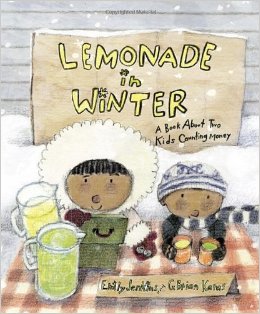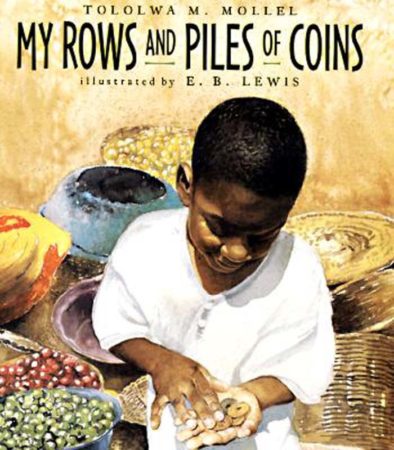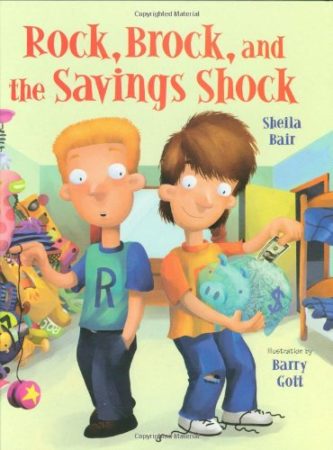 Lemonade in Winter
Lemonade in Winter
by Emily Jenkins
illustrated by G. Brian Karas
Schwartz and Wade Books, 2012
Reading Level: 2.5; Interest Level: P-3; Out Loud Reading Time: 5 minutes 55 seconds
Determined Pauline and little brother John-John decide to sell lemonade on a blustery winter day. The two siblings count money, buy needed resources at the corner grocery store, make their product, and set up a lemonade stand. As their mother predicted, they have few customers and during the slow spells they create ads, make decorations, create a jingle, and lower prices. At the end of the day they calculate their earnings and discover that they have lost money. They return to the store and purchase popsicles to help them overcome their disappointment and celebrate a fun-filled day.
Lesson plan: Pauline Makes a Decision (Grade level K-3); Source: JMU Center for Economic Education
Students consider Pauline’s decision to sell lemonade using a decision-making model. Maybe if she had given her idea some thought, she would have decided to spend her time and money differently. Students then weigh the costs and benefits of another situation ad make a decision.
Click Here to Download the Lesson Plan
 My Rows and Piles of Coins
My Rows and Piles of Coins
by Tololwa Mollel
illustrated by E.B. Lewis
Houghton Mifflin, 1999
Reading Level: 3.8; Interest Level: K-5; Out Loud Reading Time: 6 minutes 58 seconds
Saruni, a Tanzanian boy, helps his mother carry produce from their home to sell at the market. Saruni’s mother pays him for his help with a few coins and urges him to spend his earnings on something he wants. His goal is to buy a bicycle that will help his mother transport goods to the market. With this goal in mind, Saruni saves his money. The disappointment he has when he realizes how expensive bicycles are is replaced with delight when his parents surprise him with a used bicycle. Saruni quickly plans a new savings goal. He will save money to buy a cart for the bicycle.
Lesson Plan: Saruni Makes a Choice (Grade level 2-4); Source: JMU Center for Economic Education
Using the facts in the story, students learn about using a decision-making model to help them consider the costs and benefits of a choice before making a decision. They then apply this skill to another problem.
Click Here to Download the Lesson Plan
Rock, Brock, and the Savings Shock
and the Savings Shock
by Sheila Bair
illustrated by Barry Gott
Albert Whitman & Company, 2006
Reading Level:5.0; Interest Level: 2-5; Out Loud Reading Time: 5 minutes 3 seconds
Rock and Brock may be twins, but they are not alike when it comes to physical appearance, personalities, and spending habits. Neat and organized Rock cannot resist spending his money, while messy and free-spirited Brock has amazing constraint when it comes to saving his money. The brothers learn a valuable lesson when their grandfather pays them each a dollar for doing chores and promises that for each dollar they save, he will double it for the next ten weeks. Rock quickly spends his money on silly toys, gum, and used yard-sale items. Brock resists the temptation to spend and amasses $512 by the end of the summer. All ends well when Brock shows his brother that it’s never too late to start saving.
Lesson plan: Brock & Rock and the PACED Decision-Making Model (Grade Level 4-5): Source: James Madison University Center for Economic Education
Students learn to use a PACED Decision-Making grid as a way to improve their decision- making skills.
Click Here to Download the Lesson Plan
Click here for Children’s Reading List of 60 titles, including grade level & key concepts covered.
Each year the Virginia Council on Economic Education provides comprehensive online resources customized to the three featured books in order to help solidify the concepts and further engage students.
- Click here for the 2019-20 lesson plans and activities.
- Click here for the 2018-19 lesson plans and activities.
- Click here for the 2017-18 lesson plans and activities.
- You are currently viewing the 2016-17 lesson plans and activities.
